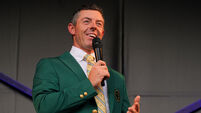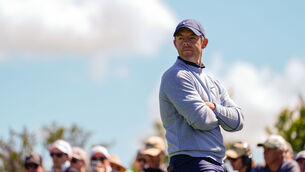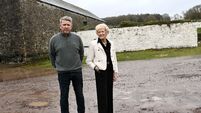Golf courses picking up the pieces after Ophelia’s rage

he storms of 2014 seem so long ago for most Irish golfers, but for some courses, October’s weather brought back painful memories.
Kilkenny, Fermoy, Charleville, Dundrum House, Thurles, and Limerick golf clubs lost over 2,000 trees between them. Bunclody lost their entire practice range facility and the course was closed for a month. In the end, though, the number of clubs suffering serious damage was a small proportion of Ireland’s total. When Ophelia touched down — when it hit Ireland it had been downgraded to ex-Hurricane Ophelia — exactly one month ago, it was a different ball game. The entire country battened down the hatches and courses closed ahead of the Monday onslaught.
One general manager, returning to work the day after, said he and the staff were terrified at the devastation they’d find… only to discover just two trees and a handful of branches had fallen.
In the end, Ophelia didn’t inflict anything like the damage that was feared. That’s not to say there wasn’t a severe loss of trees; Fermoy Golf Club again bore the brunt, but with wind gusts reaching 156kmph on land (190kmph at sea), and headlines proclaiming Ophelia had evolved from the strongest east Atlantic hurricane in 150 years, there was a feeling around Irish golf clubs that we’d got off lightly.
Today, with clear-ups completed, winter golf is back to normal, but what did Ophelia leave behind? The simple answer: A mixed bag.
The worst affected areas according to Met Éireann were Cork, Clare, Galway, Waterford, and the Midlands, but an survey has found it was the golf clubs along the southern stretch which were worst affected.
Fermoy’s loss of over 700 trees was a cruel blow during its 125th year. It was the worst damage experienced at any course by far. Trees fell throughout the property and around the perimeter and the course was closed for almost two weeks.

Macroom lost over 50 trees and fellow Cork club Monkstown lost a couple on the front nine and between 20 and 30 on the back. Kinsale lost 40 to 50, while its phone lines are still down. Charleville only lost three trees and must have been relieved after the loss of over 300 in 2014. There was also minor damage to the roof of the pro shop.
At Fota Island, the tree-shrouded driveway into the resort was blocked for a time, but there was nothing of consequence across the 27 holes. Lee Valley, Muskerry, Douglas, and Cork golf clubs also saw some trees down, but nothing significant, while Castlemartyr and Mallow lost just a handful of branches.
Co Waterford was also badly affected. Waterford Castle lost large trees, which came down and blocked the avenue to the hotel and golf course, and Tramore lost some of the enormous pine trees on the left of the 18th fairway. Faithlegg, next door to Waterford Castle, had no damage at all. The same story played out at Dungarvan, where Dungarvan Golf Club had no damage, but Gold Coast, just to the south, lost 75 trees, and West Waterford, to the west, lost close to 20. At Gold Coast, perched on the edge of Dungarvan Bay, none of the 75 trees caused any damage, but the ground was so soft that tractors couldn’t gain access to the course to remove them for several days.
o Kerry avoided the brunt of the storm. Lough Leane rose ominously but did not invade Killarney Golf Club, as it has done in recent years. Battle-hardened Cormac Flannery, the general manager, referred to it as “another windy day”. Ring of Kerry had a few trees down but, again, the feeling was one of relief.
Galway and Clare were also affected. Galway Golf Club lost close to 20 trees and the clubhouse received some damage. The overall cost came to €2,000, excluding the cost of replacing the trees. The innovative straw bale defences erected at Doonbeg, along a large portion of the course’s coastline, proved effective. Damage was kept to a minimum, but it will no doubt reinforce the argument for rock armour to be put in place. Shannon, meanwhile, was left unscathed.
Killeen Castle in Meath is Ireland’s largest golf course (covering 300 acres of a 12th century estate). Remarkably, only one large tree was lost on the course, on the right hand side of the 10th fairway. It has already been noted that those with a slice are quietly delighted. Mount Juliet had a lucky escape with their new clubhouse: The idyllic parkland lost a few big trees, with one coming within inches of demolishing the clubhouse. In the end, it only removed a few tiles. Luttrellstown Castle, outside Dublin’s M50, saw only a few branches down, while Slieve Russell, in Co Cavan, reported the same.
At Malone, outside Belfast, several trees fell, with some falling across a private road next to the course. It took three of the greens staff (all qualified to use chainsaws) two days to clear the trees from the road. All of the good wood will now be cut up, stored, seasoned and then sold to members. It’s a smart use of resources.
At Galway GC, the fallen trees have all been chipped and will be used around the clubhouse for decorative purposes and on flowerbeds. At Powerscourt, five big trees (oak and beech) came down on the East Course. A contractor came in to remove them and took the wood as payment. At Fermoy, volunteers were also offered wood as a way of saying thank you.
The most interesting story came from Bunclody Golf Club. It boasts one of Irish golf’s great entrances, winding through towering oak and beech trees beside the River Slaney. Several of these trees fell, blocking the entrance, but the course was mostly untouched. The more serious damage came a few days later when, with the river blocked upstream and fences knocked down by the winds, a herd of cattle crossed the Slaney, climbed the bank and ran amok on one end of the course. Two greens were trampled, with hoof marks sinking three to four inches into the putting surfaces, while fairways were also pummelled. The course was quickly back to its usual pristine self and there was no need to close for a month, as in 2014.
For some courses, unfortunately, even the minimal loss had a major impact. At Powerscourt, the lone tree, which shadowed the green on the East Course’s famous 17th, succumbed and, at Monkstown, the lovely old tree guarding the sixth green and seventh fairway was uprooted. Enniscorthy lost two significant trees on holes 11 and 13, and the fallen trees on the left of Tramore’s 18th were a feature of the hole.
The overall feedback is that courses on roughly a diagonal line from Co Cork to Co Wicklow were the worst affected. The over-riding feedback was that some trees and branches came down, but no damage was done to the course. Even at Fermoy, the greens and fairways were left unscathed. Most courses were open within a couple of days.
If weather forecasters are to be believed we’re in for a tough winter but, for now, we can look back on Ophelia’s rampage and breathe a sigh of relief.
Fermoy members pull together

The devastation at Fermoy has highlighted the unity of spirit that exists at country clubs. The day after Ophelia, senior members rallied to the cause and arrived en masse at the club to assist the greenkeeping staff, led by Tomás O’Flynn. Anyone who was certified to use chainsaws was quickly put to work and up to 30 volunteers returned day after day, many arriving at 9am and not leaving until 5pm. The club fed them during the 12-day clear-up and the bar was kept busy, as the workers enjoyed a hard-earned drink when it fell dark.
The volume of work carried out was astounding. Over 100 trees were shifted in a day-and-a-half in the grove along the perimeter of holes eight and nine. It helped greatly that course manager Pat Roche is a former Coillte man. The course (14 holes) was back in play after 10 days and the full 18 opened last weekend. Club secretary/manager Denis Twomey estimates that without the huge efforts of the volunteers and greenkeepers, and the direction of Pat Roche, it would have taken months and thousands of euro to get the course open again.
Two societies played Fermoy over the weekend and were astounded by the excellent condition of the course and how it looked. It just goes to show that, when a club pulls together and people cherish a special resource, nothing is insurmountable.















